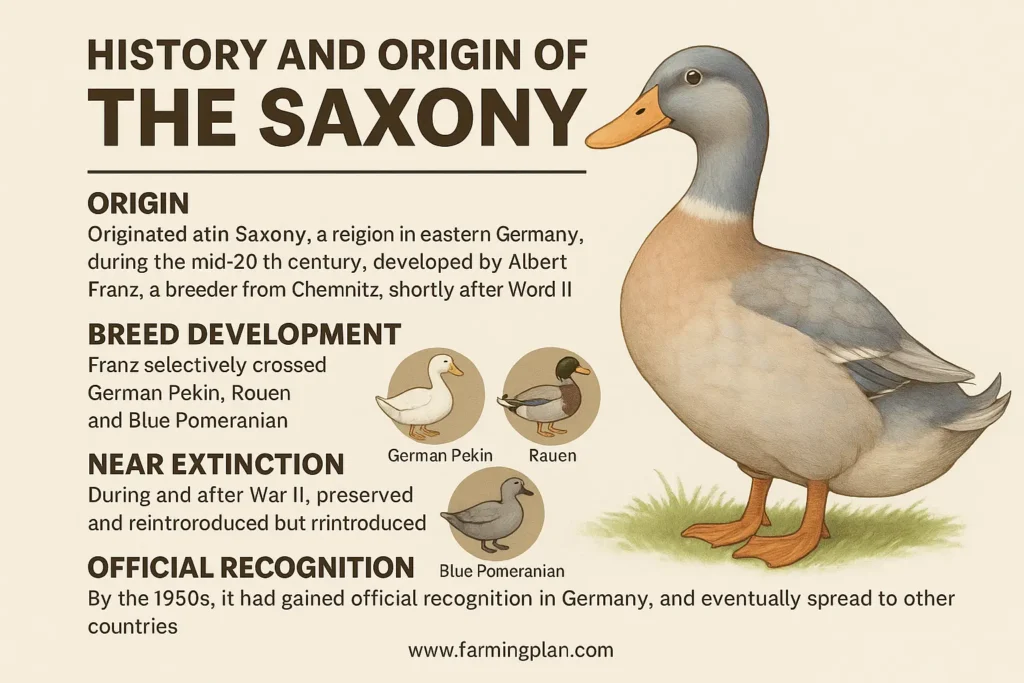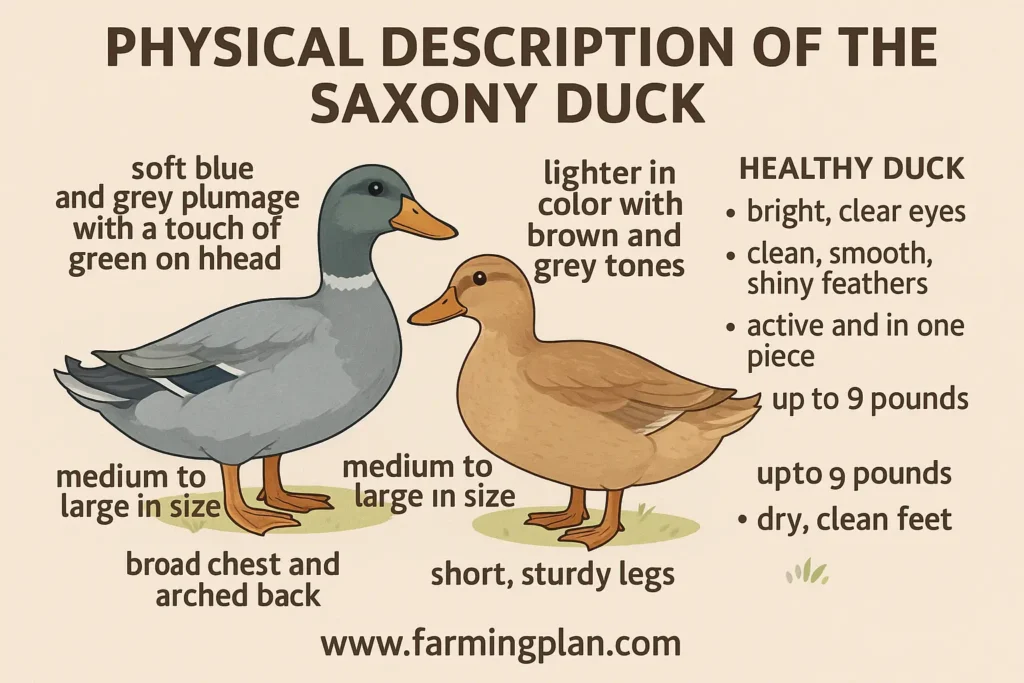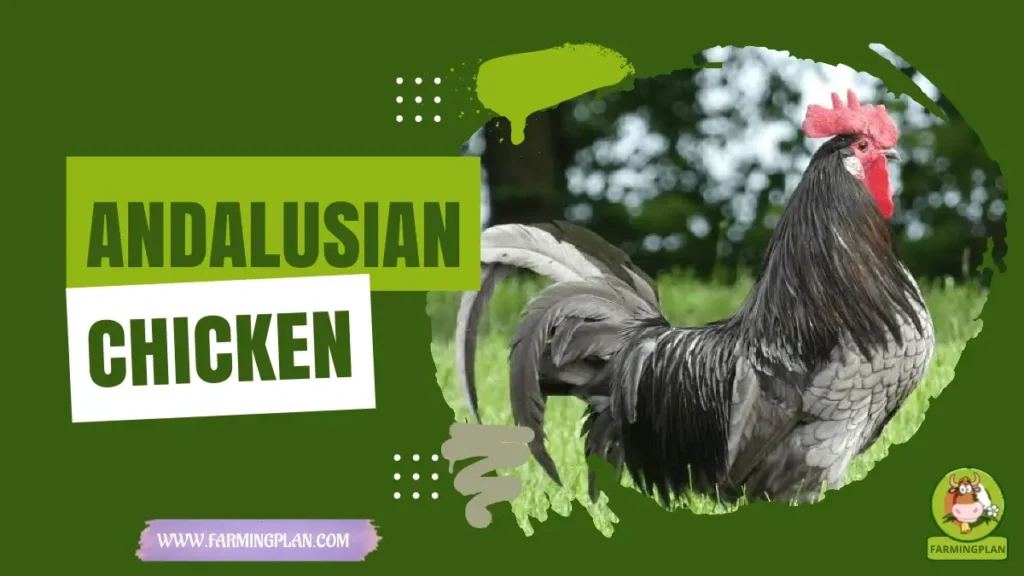Welcome to the lovely world of the Saxony duck, one of the friendliest and most adaptable breeds that have become so well-liked among homesteaders and pet owners. Beautiful feathering, gentle disposition, and adaptability to fit many different settings make Saxony ducks a homestead and farm favorite in no time. Whether you’re looking to include them in your farm or are just wondering what all the fuss is about, this article will provide a comprehensive rundown of everything you need to know about the Saxony duck.

History and Origin
The Saxony duck originated in Saxony, a region in eastern Germany, during the mid-20th century. It was developed by Albert Franz, a breeder from Chemnitz, Saxony, shortly after World War II. In the wake of the war, there was a strong need for efficient, dual-purpose poultry breeds that could provide both meat and eggs under varying farm conditions.

To create the ideal bird, Franz selectively crossed several duck breeds, including the German Pekin, Rouen, and Blue Pomeranian. His goal was to combine resilience, productivity, and aesthetic appeal—resulting in a duck that was hardy, fast-growing, and visually striking with its soft buff-blue plumage.
However, the Saxony duck faced near extinction during and after the war due to the destruction of livestock populations and the introduction of more commercially dominant breeds. For a time, the breed was almost lost. Fortunately, through the dedication of enthusiasts and breeders who recognized its value, the Saxony duck was preserved and later reintroduced.
By the 1950s, it had gained official recognition in Germany, and it gradually found its way into other countries, including the United States and the UK, where it was embraced by small-scale farmers and poultry fanciers alike. Today, the Saxony duck is celebrated not only for its utility but also for its calm temperament and elegant appearance, making it a favorite among homesteaders and heritage breed enthusiasts.
Physical Description
The saxony duck is recognized by its handsome looks, with distinctive coloring that sets the males apart from the females. The male Saxony ducks, or drakes, sport a lovely soft blue and grey plumage, sometimes with a touch of green on their heads, which provides them with a sophisticated, nearly iridescent appearance. On the other hand, Saxony female ducks tend to be lighter in color, with less prominent brown and grey tones. The difference in colour makes them beautiful and easy to identify for their owners.

The Saxony duck is a medium to large breed by weight and size. Adult ducks weigh 6 to 8 pounds, and drakes are a bit heavier, up to 9 pounds. The breed has a good proportion of body with a broad chest and arched back, making them strong and elegant swimmers and walkers. The breed has short but strong legs that enable them to walk easily.
To determine if a Saxony duck is healthy, look for bright, clear eyes and clean, smooth, shiny feathers. A healthy duck’s body should be firm and in one piece with no sign of sickness, such as limping or unusual behavior. Healthy ducks also have dry, clean feet and are very active. An adequate diet, proper care, and regular checkups will see your Saxony ducks in tip-top shape so you can enjoy their beauty and charm for many years.
Gentle Nature and Behavior
One of the Saxony duck’s most characteristic traits is its gentle and friendly disposition, making it a perfect choice for farmers and pets. Compared to some of the other duck breeds, which can be skittish or standoffish, Saxony ducks are renowned for being affectionate and very friendly. They seem to like people and follow their owners to get close to them. This friendly demeanor also makes them a great family pet since they enjoy being around people and can grow used to frequent handling.
Saxony ducks are usually excellent-tempered with children. They are patient and easy-going, making them an excellent choice for a family with young children. Nevertheless, as with any other pet, children should still be educated on how to handle them gently, as the ducks, friendly as they are, can also be frightened or stressed if not handled carefully.
Because of their hardiness and friendly nature, Saxony ducks make an excellent partner for farmers. They do well in diverse settings, whether on a small hobby farm or a more extensive commercial operation. Their amiable temperament makes them easy to handle and compatible with other animals, such as ducks, chickens, and geese. Whether for their utility around the farm or as a cherished pet, Saxony ducks offer valuable benefits and pleasant companionship.
Read More: Discover the Amazing Appleyard Ducks: Ultimate Guide
What Saxony Ducks Like to Eat

The Saxony duck eats a diverse and nutritious diet, which makes it healthy, contented, and productive. When in the wild, it grazes on grasses, cereals, bugs, and greens. The natural diet is rich in nutrients and gets the right amount of vitamins and minerals to thrive.
Best Natural Foods for Saxony Ducks:
- Grasses and Greens: Fresh grass, clovers, dandelions, and leafy greens such as kale and spinach can be part of their diet.
- Grains: Oats, barley, and cracked corn are a few whole grains that ducks like, which provide energy and good growth in ducks.
- Insects and Bugs: Ducks chase and eat insects, worms, and small animals. Let your Saxony ducks free-range in a secure outdoor space to graze on these goodies if feasible.
some feeding tips:
- Balanced Diet: Give a healthy mix of fresh greens and grains daily and a clean water source.
- Duck Pellets: Natural food for ducks may also be supplemented using high-grade duck pellets or crumbles to feed them all the essentials.
- Portion Control: Ducks love to eat but don’t overfeed them. Feed them at specific times and give them only what they can consume in hours.
Water Access is highly crucial to Saxony ducks. They need fresh water to help digest and maintain their feathers in good health. While swimming is a joy to ducks, even a shallow bowl or pool will suffice for drinking and wetting their heads.
Healthy Treat Ideas:
- Vegetable Scraps: Saxony ducks like carrot greens, lettuce greens, or peas will welcome.
- Berries: Fresh black or blueberries can be an excellent and healthy snack.
- Mealworms or Earthworms: This is a nice high-protein treat that ducks love!
You can make your Saxony ducks happy and healthy by feeding them a balanced diet with these natural treats and supplementing them with fresh water.
Common Uses: More Than a Pretty Duck
The Saxony duck is valued for its beauty and friendly nature. It also provides valuable benefits, making it a worthy asset to hobby and commercial farms. The breed is extensively valued for its usefulness and versatility, especially in egg production, carcass quality, and general farm purposes.
- Egg-Laying Ability: Saxony ducks are distinguished by their high egg-laying capacity. They are excellent egg layers that produce large, white, well-regarded eggs. A healthy Saxony duck can lay 200 to 300 eggs per year. Their eggs are often considered a delicacy because they are vast and rich in flavor, making them a great addition to any home or backyard farm that appreciates fresh eggs.
- Meat Quality and Agricultural Value: Apart from their ability to lay eggs, Saxony ducks are also valued for their meat. The meat of a Saxony duck is lean, flavorful, and tender, which makes it a top choice for duck raisers who eat the ducks. Being both good layers and having good meat quality makes them a dual-purpose breed, offering farmers economic and culinary value.
- Role in Backyard Farms and Hobby Farms: Saxony ducks are suitable for small backyard and hobby farmers. Their smaller size and friendly nature are manageable, and their egg and meat production ensure a steady food source for the family.
They can also peacefully coexist with other farm animals like chickens and geese and are a very suitable choice for multi-species farms. Their beautiful looks and gentle temperament make them a pleasure to keep and manage, and they bring an element of elegance and productivity to any farming setup. Overall, the Saxony duck is worth more than its pretty face—it’s a practical and valuable addition to any farm, with utility value and a dash of charisma.
“A Saxony Duck Is Not Just A Bird; It’s A Bundle Of Joy Waddling Into Your Life.”
Special Features That Make Them Stand Out
Saxony duck is an easily identifiable breed owing to its appearance and special characteristics, so it is a popular pet, farm, and hobbyist choice. Some of its distinguishing features are listed below:
- Breathtaking Plumage and Silky Feathers: Perhaps the most striking aspect of the Saxony duck is its gorgeous plumage. Drakes are adorned with a soft blue-grey plumage with a slightly iridescent lustra , while the females wear a duller combination of grey and brown. Their feathers are aesthetically pleasing and amazingly silky, making them even more endearing. These ducks are a real head-turner in any flock!
- Cold-Hardy and Weather-Tolerant: Saxony ducks are suited to colder climates, making them an excellent choice for farmers who live in regions with harsh winters. Their thick, water-resistant feathers insulate them from the cold even in inclement weather, and they continue to forage and move around outdoors throughout the year. This aspect of cold-hardiness is a massive advantage for residents of northern states or those individuals who reside in regions with unpredictable climates.
- Suitable for Beginners: The Saxony duck’s differentiating characteristic is their peaceful, friendly nature. Saxony ducks are well-known for being extremely relaxed, perfect for beginners new to duck keeping. They are calm and social, so handling and maintaining them is not challenging.
With their stunning appearance, hardiness in cold climates, and friendly yet watchful nature, Saxony ducks are a breed that has everything going for them in the way of appearance and utility. They genuinely are a top-notch breed in any flock!
Read More: Ancona Duck Disasters You Can Easily Prevent for Brilliant Farming Results
Health Issues & How to Prevent Them
Like all ducks, the Saxony duck is prone to some health problems, although these are simple enough to prevent or treat with proper care and attention. It is important to know about the common health issues that Saxony ducks may be prone to and how to ensure they remain in good health.
Common Duck Diseases
Like most ducks, Saxony ducks are susceptible to internal parasites like worms. These can cause them to lose weight, become lethargic, and experience stunted growth. Regular deworming is necessary to prevent this. Bumblefoot occurs when a duck develops sores or abscesses on its feet, typically from standing on wet and dirty surfaces for a long time. To avoid this painful condition, it is best to keep the duck’s environment clean and dry.
- Wet Feather: Wet feathers are a condition ducks get when their feathers get too damp and fail to dry. This can cause hypothermia in cold weather and cause discomfort for the duck. Providing your ducks with a dry, covered space and warm water to bathe correctly can prevent this.
- Basic Methods of Raising Healthy Saxony Ducks: Clean Living Environment: Ducks require frequent cleaning of their bedding and living space to avoid parasites and infections. They are unclean animals, so keeping their house clean is essential for their health.
- Good Diet: A well-balanced diet of quality pellets, greens, grains, and freshwater will make your ducks healthy and robust. Do not forget to provide them with grit to aid digestion.
- Dry, Clean Feet: Their feet should be inspected regularly for any sign of bumblefoot, and their walking areas should be dry and clean. Always provide them somewhere to dry off afterwards when they swim or forage.
Vaccination & Vet Visit Suggestions
Although all duck breeds do not need vaccination, Saxony ducks can appreciate regular veterinary visits, particularly when you have more. A veterinarian may advise your ducks on whether they should get vaccinations against typical duck illnesses. Schedule annual vet visits to monitor their health and catch potential issues early. Parasite inspection, feather condition, and foot health are all routine inspections needed to keep your ducks in top shape.
Keeping the living area clean, eating a good diet, and watching for prevalent health issues will avoid most health issues in Saxony ducks. With a bit of attention and care, these social ducks will remain happy and healthy for years!
Read More: Forest Duck: Farm Today
Step-by-Step Guide to Farming
Raising Saxony ducks can be a rewarding experience for both pet owners and farmers. Their gentle nature and productivity make them easy to manage, but they do require a little attention and care. Here’s a step-by-step guide to ensure that your Saxony ducks stay happy, healthy, and thrive in their environment.
Prepare a Safe and Clean Coop: Ensure that your ducks have a clean and secure coop to protect them from predators and harsh weather conditions. The coop should be well-ventilated, spacious enough for them to move freely, and dry. Make sure to clean the coop regularly to prevent the build-up of harmful bacteria.
Create a Source of Shallow Water: Ducks love water, so it’s essential to provide them with a shallow pond, kiddie pool, or any safe water source for them to dip into. This helps keep their feathers clean and allows them to engage in natural behaviors like swimming and foraging.
Feed Them Twice a Day and Provide Grit: Saxony ducks require a balanced diet for optimal health and egg production. Feed them twice a day with high-quality duck feed, which should be supplemented with fresh vegetables, grains, and occasional treats. Grit is also important for their digestion, so make sure they have access to it regularly.
Clean Bedding Regularly: The bedding in your ducks’ coop should be kept clean and dry at all times. Use straw, wood shavings, or other absorbent materials to line the floor. Regularly replace soiled bedding to prevent odors and health issues.
Provide Shade and Shelter: Throughout the Year Ducks need shelter from extreme temperatures, whether it’s the hot summer sun or the cold winter weather. Ensure that your ducks have access to shaded areas during hot weather, and a well-insulated coop during the colder months to keep them comfortable year-round.
Check Their Feet and Feathers Weekly: Regularly inspect your Saxony ducks’ feet and feathers for any signs of injury, parasites, or infections. Healthy feet are essential for their well-being, so look out for signs like swelling or tenderness. Clean their feathers gently to help maintain their water proofing.
Handle Them Gently to Gain Their Trust: Saxony ducks are known for their friendly and docile nature. To build trust and bond with them, handle them gently and regularly. This will help them feel comfortable around you, making it easier to manage them for health checks or routine care.
FAQ
What are the origins of the Saxony duck?
The Saxony duck was created in Germany during the 1930s by Albert Franz from a cross between Rouen, German Pekin, and Blue Pomeranian ducks.
How many eggs do Saxony ducks lay per year?
Saxony ducks are decent layers, laying 190 to 240 big white eggs annually
Are Saxony ducks friendly and good with children?
Yes, Saxony ducks are very friendly and gentle, making great pets for families with children.
Do Saxony ducks need water to swim in?
Saxony ducks do like to swim, but it is enough to provide them with a shallow or even a kiddie pool to satisfy them; they don’t need a large pond.
How long does a Saxony duck live on average?
Saxony ducks live for 9 to 12 years, providing years of companionship and productivity.
Conclusion
The Saxony breed of ducks is excellent and beloved for their amiability, high egg production, and suitability for differing environments. They are from Germany and have a fascinating history, making wonderful additions to small and large farms. They are cold-hardy and gentle, making them well-suited to several climates and families. However, they should know their probable health issues, such as bumblefoot and worms, and take preventive action early. Generally, Saxony ducks are an excellent and productive choice for anyone who would like a friendly and productive duck breed.

